Table of Contents
What is meiosis?
Meiosis is a type of cell division whereby the cell divides two times through two phases known as Meiosis I and Meiosis II to form 4 daughter cells. Each daughter cell contains half of the parent’s number of chromosomes. This process occurs only in the sex cells which are spermatozoa and ova.
These two gametes (spermatozoa and ova) differentiate to form the various cells and tissues of the body. This is the reason why they are called Germ cells (which are cells that can differentiate to produce other cells). The process starts with a single diploid cell and produces four haploid cells.
It is part of the cell cycle too just like mitosis. For you to better understand what meiosis is all about, you need to understand the types of cells in the body. There are two types of cells in the body: the sex cells (involve in the production of the spermatozoa in males and also involved in the production of ova or eggs in females) and the somatic cells (the body cells that make up different cells and tissues of the body).
When the body needs to replace a damaged part of the mouth or gastrointestinal tract or part of the skin, the body initiates the process of Mitosis in the cells of that tissue. The surrounding healthy cells of the damaged tissue will divide to replace the damaged ones. All this process occurs when the cell receives a signal to enter the M-phase of the cell cycle.
When the cell has not received a signal (that is when no cell is damaged) what the cells do is to continue their normal functions in the body (this is the interphase phase of the cell cycle). This is what happens in somatic cells (body cells).
In the sex cells (gametes), the cell cycle occurs too. When the spermatozoa or ova are not dividing, they will continue to grow to maturity in where they are stored. For the female, when the egg (ovum) matures and is released without meeting the spermatozoon, it will disintegrate and flow out of the female body in the process of menstruation (menstrual cycle).
When the egg meets and fused with the spermatozoon, a zygote is formed and the process of forming a fetus to a baby starts.
What this means is that the sex cells also undergo the cell cycle and they have the interphase as well as the M-phase too; therefore the M-phase of the cell cycle in sex cells (or gametes) is called Meiosis just as the M-phase of the cell cycle in somatic cells is called Mitosis.
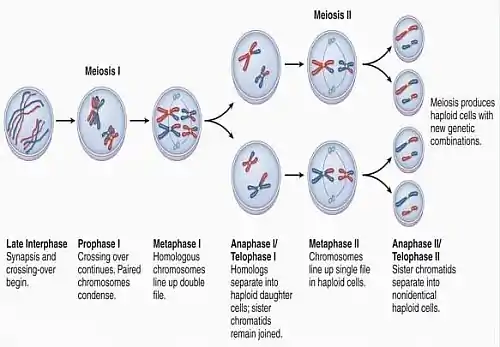
Definition
Meiosis is a type of cell division occurring only in sex cells or gametes (such as spermatozoa and ova) that involves a single parent cell dividing to produce four daughter cells. These are genetically different and each of the daughter cells having half of the number of chromosomes of the parent cell (this is the reason why meiosis is also called the reduction division process).
Examples include oogenesis, spermatogenesis, and spores formation in plants.
Definition of terms
There is a need to explain some terms used to describe this for you to understand easily.
- Diploid cell: a diploid cell is used to refer to a cell having two complete sets of chromosomes (from the male and female parent in humans, this number is 23 male plus 23 female parents giving rise to 46 chromosomes); the abbreviation for diploid is 2n
- Haploid cell: a haploid cell is used to describe a cell having one complete set of chromosomes. The abbreviation for haploid is n.
- Crossing over: refers to the exchange of genetic components by the chromosomes in a sex cell (gamete) before the cell division. Crossing over leads to genetic variability and occurs in the interphase and prophase 1 of meiosis. It is started in interphase and continued in the prophase 1 stage.
- Bivalent chromosomes: these are chromosomes from male and female parents which normally line up to form synapsis or exchange points (chiasmata) in the prophase 1 phase.
- Synapsis (also called Crossing over): this is the process whereby bivalent chromosomes join at meet points called Chiasmata to exchange genetic components
What is the purpose of meiosis?
The main function of meiosis is to produce gametes (sex cells) such as the male gamete (known as Spermatozoa) and the female gametes (ova). The process for the production of male gametes is called Spermatogenesis, and the process of producing the female gametes is called Oogenesis. The general name for the production of gametes (both the female and male gametes) is called Gametogenesis. Whatever is going on during oogenesis or spermatogenesis is the process of meiosis. Without these cells, reproduction will not be possible. Therefore, it can occur in both animals and plants.
Functions of meiosis
- It helps in the production of male sex cells
- Important in the production of female sex cells
- Abnormal meiosis leads to chromosomal abnormalities such as Down syndrome (trisomy 21), Klinefelter syndrome (47, XXY or XXY) and other chromosomal anomalies.
- It keeps the process of reproduction
The Process of Meiosis
This process involves two steps: Meiosis I and Meiosis II; each of these two steps of meiosis has stages just as in mitosis: prophase, metaphase, anaphase, and telophase. The explanation of each step with the stages will be described below with diagrams to help in understanding. The number of chromosomes shown in the diagrams has been reduced to make it easy for understanding.
Steps of meiosis
- Meiosis I
- Meiosis II
Each step has stages just as in mitosis but is named with a number after every stage to signify the step. So there will be prophase 1 (to signify prophase stage of meiosis 1); metaphase 1 (to signify metaphase stage of meiosis 1) while metaphase II (or metaphase 2) refers to metaphase stage of meiosis 2.
Stages or Phases of Meiosis
The stages of meiosis are similar to mitosis with few differences especially in Meiosis 1. Meiosis 2 is very similar to Mitosis but ends with the production of 4 genetically variable haploid daughter cells.
Stages of Meiosis 1
- Prophase 1
- Metaphase 1
- Anaphase 1
- Telophase 1
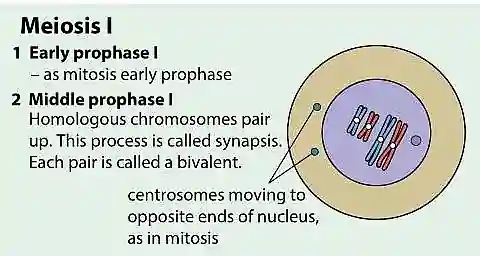
Diagram of early Prophase 1
Prophase 1
- In early prophase I, the chromosomes condense and become visible
- Homologous chromosomes pair up to form bivalent chromosomes
- Crossing over of chromatids to exchange genetic components occurs in this stage
- The members of each chromosomal pair can be seen repelling each other but are still held at the crossing-over points called chiasmata
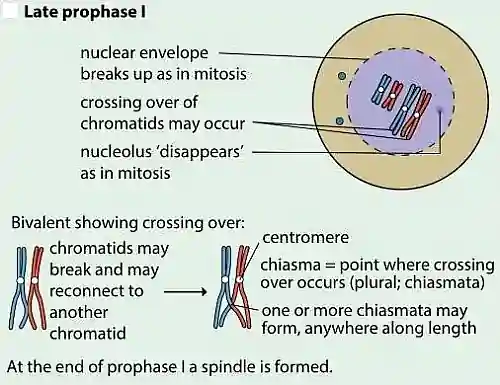
Late Prophase 1 stage of Meiosis 1
Metaphase 1
Bivalents chromosomes line up across the equator (center or middle) of the spindle fibers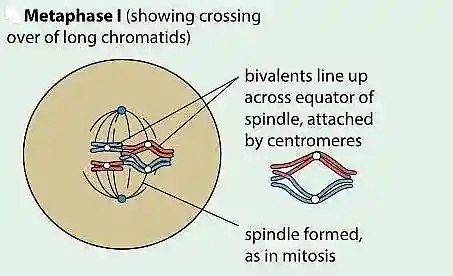
Diagram of Metaphase 1
Anaphase 1
In anaphase I, the homologous chromosomes move to the opposite poles of the spindle fibers
Anaphase 1
Telophase 1
- Chromatids separate
- Reformation of nuclear envelope occurs
- The cell begins to divide (cytokinesis)
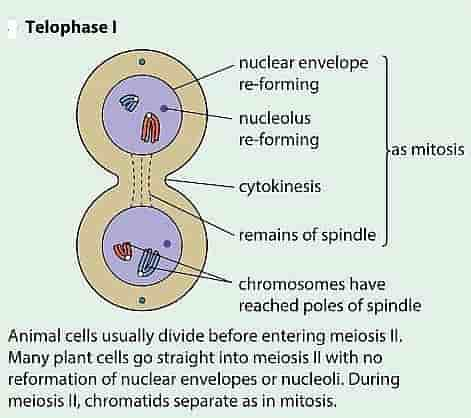
Telophase 1
Animal cells usually divide before entering meiosis II but in many plant cells, there is no reformation of nuclear envelope or nucleoli.
Stages of Meiosis 2
- Prophase II
- Metaphase II
- Anaphase II
- Telophase II
In meiosis 2, the two cells produced in meiosis 1 will now divide again to form 2 more cells bringing the total to 4 daughter cells.
Prophase II and Metaphase II
Prophase 2
- The nuclear envelope and nucleolus disappear
- Centrosomes and centrioles replicate and move to opposite poles of the cell
Metaphase 2
Chromosomes line up separately across the equator of spindle fibers
Anaphase II stage
Anaphase 2
In this stage, the centromeres divide and the microtubules pull the chromatids to opposite poles
Telophase 2
Telophase 2
- Cytokinesis occurs for the second time
- The telophase II phase is as that of mitosis, but with the production of 4 haploid daughter cells
FAQs and Facts about the process of meiosis
Number of chromosomes produced at the end of meiosis
The number of chromosomes in a parent cell is reduced by half so that every daughter cell gets half of the number of chromosomes that the parent cell had.
How many daughter cells are produced?
Four daughter cells are produced from a single parent cell in Meiosis and each of these daughter cells has a different genetic makeup or composition from others. This genetic variability of the daughter cells occurs due to the crossing over of chromosomes that occur in Meiosis 1 leading to the exchange of genes. This is different from Mitosis in which a single parent cell divides itself to form two daughter cells.
How many cell divisions occur during meiosis?
Two cell divisions occur. The first cell division is called Meiosis 1 and it is a reduction process where the number of chromosomes of the parent cell is reduced by half while the second cell division is called Meiosis 2 and involves the crossing over of chromosomes.
What type of cell undergoes meiosis?
Only the sperm cells (spermatozoa) and the ova undergo meiosis; this means that only gametes (sex cells) undergo this process.
What is the end result of meiosis?
The end result of meiosis is the production of four daughter cells that are genetically different from each other even though all received their genetic composition from the parent cell. The number of chromosomes in each of the four cells produced is half of the number in the parent cell.